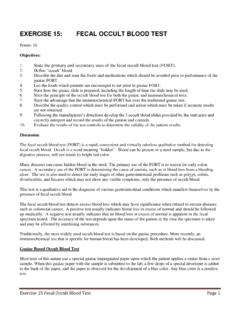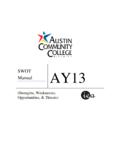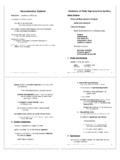Transcription of 6.5% NaCl Broth Salt Tolerance Test
1 NaCl Broth salt Tolerance Test TYPE OF ORGANISMS: Streptococci PURPOSE: Presumptively identify Group D enterococci DISCUSSION: Were you ever told to gargle with salt water when you had a sore throat or after you d had dental work done? This is because high salt concentrations inhibit the growth of certain organisms, such as many streptococci. Throughout the course of the semester in Intro to Micro, you have learned about many selective and differential tests you can use to classify an unknown organism. One helpful test is the test for salt Tolerance . This test can be used to differentiate Group D enterococci from Group D streptococci, as Group D enterococci are the only streptococci that will grow in NaCl Broth . Once you ve decided the organism with which you re working is a streptococcus, you can use bile esculin, bacitracin sensitivity (A discs), and hemolysis to help you determine whether or not you have a Group D streptococcus. Then you can use the salt Tolerance test to help you decide if it is a Group D streptococcus or a Group D enterococcus.
2 In the Mannitol salt Agar test, you used salt Tolerance to selectively culture organisms. The MSA plates have a salt concentration of The phenol red indicator and mannitol (a sugar) in the media helped you determine if the organisms that grew fermented mannitol. If the organisms did ferment mannitol, the plate turned yellow due to the acidic byproducts of that fermentation. So the MSA plates are a good example of media that is both selective and differential. The NaCl Broth is selective only, which means that you will read it by determining whether or not an organism grew. There will be no color change. The salt used in both the MSA plates and the NaCl Broth is sodium chloride, or regular table salt . NaCl Broth is Tryptic Soy Broth with additional NaCl added to raise the total salt concentration to Tryptic Soy Broth is a general-purpose nutritive Broth which is used to culture organisms that need more nutrients than regular nutrient Broth provides.
3 Streptococci are one example of these fastidious organisms. PROCEDURE: 1. Work in pairs. 2. Using aseptic technique, inoculate two NaCl Broth tubes. Use E. faecalis and S. pyogenes. 3. Incubate at 37 C. 4. During the next lab, compare the incubated tubes with an uninoculated control. Determine which organisms grew and which organisms did not grow. 5. Record your results.

















